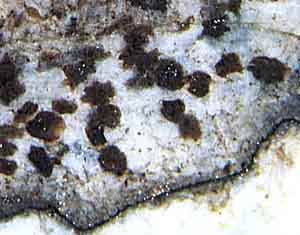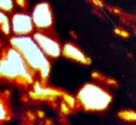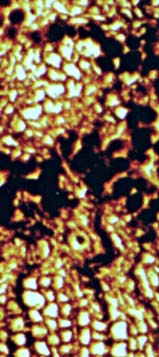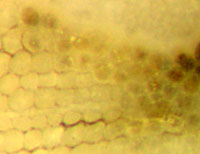Wood rot or coprolites ?
Evidence for live and dead plants being attacked and
partially
consumed by fungi or small creatures is found as far back in time as
the Lower Devonian. If not preserved in chert or, in later times, in
fossil
wood, such evidence is hard or virtually impossible to find.
This
may explain why the examples presented here cover only the Rhynie
chert
plants and silicified wood from a few locations but
not the
vast
majority of plants preserved as compression fossils.

Fig.1: Asteroxylon
in Rhynie chert, tissue mostly destroyed by fungus activity (above
left), detail of cross-section: individual cells filled with dark
matter, thus remaining clearly visible while the empty cells are no
more seen.
For Rhynie chert plants affected by fungi and unknown creatures see:
Rhynie
Chert News 4, 21
fungus-induced
growth anomaly
Rhynie
Chert News 7
spore
eaters
Rhynie
Chert News 28
cell-size
clots
Rhynie
Chert News 37
arthropod
borings
Rhynie
Chert News 85
cell-size
clots
As
a conspicuous phenomenon persisting through the ages from the Lower
Devonian to present times, cell-size clots similar to those in Figs.1,2
are often present in wood,
usually at or near spots of damaged tissue. The clots are seen inside
cells as well as scattered around where the tissue is decayed. Clots
filling the wood cells of extant trees are produced by several fungi
[1], as Acanthophysium
sparsum, for example. 
Fig.2: Psaronius
aerial root phloem cell with dark fill surrounded by
empty cells. Detail from [4], Fig.8, there erroneously denoted
as aerenchyma instead of phloem. (Note also the
typical shape of a collapsed cell below
the filled cell, as it is often seen in slightly compressed wood.) The
dark fills have been interpreted as coprolites in
[4].
(See no coprolites .)

Fig.3 (right): Permian wood, alleged frass gallery with coprolites
according to [4], Detail from [4], Fig.17.
What is really seen here is deformed wood with part
of the cells filled with dark matter but neither coprolites nor
gallery.
Note the angular shapes of some of the clots, the kinked pith ray with
dark fill, and the small clot in a large cell nearby. (Gert Müller (Dresden) had noticed the misinterpretation immediately after the release of [4] in 2010 and informed the author M.B. accordingly.)
It seems incomprehensible why palaeobotanists did not consider fungus
or microbial activity as possible explanations of the clots but brought
up the idea of
oribatid mite coprolites without any oribatid
mite at hand throughout the Carboniferous, Permian, and Triassic.
Apparently the mite coprolite idea spread in the 1990s by adopting
without checking but by following the hearsay principle, with the result that there are a number of dubious
papers on alleged mite coprolites in scientific journals and
books. Instead
of engaging in discussion based on fossil evidence, those promoting the
idea of mite coprolites
in palaeozoic wood from all over the world defend this idea by referring to those who do
the same.
Despite of warnings against the coprolite hypothesis since 2007 [2],
more publications on the subject appeared [3,4].
The publication [4] abandoned the oribatid mites but introduced
unknown creatures, which is still a long way off the
truth that there were neither mites nor other creatures
involved.
Alleged coprolites refuted :
Fossil
Wood News 3,
4
Permian wood from Germany
Fossil
Wood News 5
Permian wood from Northern China
Fossil
Wood News 6
Psaronius,
Ankyropteris,
Permian, Chemnitz, Germany
Fossil
Wood News 7
Carboniferous coal balls,
Permian wood and ferns
Fossil
Wood News 8
Permian wood from Germany and Northern China
Fossil
Wood News 11
Triassic fern and wood from Antarctica
Fossil
Wood News 12
Ankyropteris,
Permian, Chemnitz, Germany
Silesian
Petrified Wood
silicified wood from
Poland
Fossil
Wood News 14
alleged borings
Fossil
Wood News 16
wood with light-coloured clots
Fossil
Wood News 18
Triassic
bennettitalean roots, Cretaceous bennettitalean
stem
Fossil
Wood News 20 Plyophyllioxylon, Permian, China
Fossil
Wood News 21
Palaeozoic
wood, Kyffhäuser mountains, Germany
Fossil
Wood News 22
Australoxylon, glossopterid wood from Antarctica
Fossil
Wood News 23 Permian wood from Thuringia, Germany
Fossil
Wood News 24 Permian wood from Thuringia, Germany
Fossil
Wood News 26 Permian wood from Schallodenbach, Rhine-Palatinate, Germany
H.-J. Weiss 2011,
emended 2013, 2014, 2015, 2016, 2019
Annotation 2013, 2014:
As it appears now, the controversy of "wood rot versus
coprolites" has provided the proof that lay palaebotany on the Web can
affect professional palaeobotany despite
of the claims by professionals that one must not trust anything that
has not undergone a reviewing process and has not been printed.
The fact that lots of errors and misconceptions have entered into the
scientific literature is readily ignored by those who adhere to such view.
The own effort to refute the mite coprolite interpretation of cell-size
clots in palaeozoic and mesozoic plant tissue, from 2007 on [2], has
given rise to
differential response,
ranging from tacit acceptance of the alternative view to desperate
defense of the repeatedly published one [3,4]. The effort has not been
in vain: From 2011 on, those who got in touch with the present website
seem to have abandoned the once favourite subject of oribatid
mite coprolites. Some uncertainty of the authors [6] is apparent
from formulations like "the coprolites described here ... may also
indicate the activity of ancient oribatid mites" and "the coprolites
... are interpreted to represent a new detritivore."
Some
former proponents of the mite coprolite hypothesis have been lucky to
find coprolites after all, a million times bigger than cell size in
volume, which they assign to bigger arthropods [5].
It
does not seem incidental that erroneous views in publications are
often found in combination with lack of thoroughness. Apparently there
is a causal connection, for which [7,8] provide lots of examples. Along with numerous mistaken size data, R. Rößler presents coprolites, arthropod burrows, and fossil charcoal which are no such (see Fossil
Wood News 16, 9).
Since erroneous views are virtually never
retracted in writing and hence have to be opposed by other means, the
sections "Misconceptions"
and "Errors
and
Mistakes" have been set up on this website.
Annotation 2015:
As a setback in the attempt to weed out the ill-conceived concept of mite coprolites
in connection with cell-size clots in petrified wood, two more
publications on the subject have appeared in 2014 and 2015 [9,10]. By looking closely
at the images shown there it becomes obvious that they are likewise
erronous as others before, as explained in Fossil
Wood News 23 , 24.
Annotation 2016: 
It
has been noticed only now that one sample from the own collection which
has provided evidence against the coprolite interpretation before can
also provide evidence of clot formation inside cells, beginning with a
pale clot which may or may not become darker and cause the decay of the
cell wall: Fossil Wood News 26.
Considering the new evidence and the own efforts since 2007 to refute
the worldwide accepted mite coprolite hypothesis, it may be appropriate
to confront the proponents of that hypothesis with the slogan "The end
is near". Perhaps people at the Naturkunde-Museum Chemnitz
have heeded the advice given to them and have begun to wonder why never
a fossil mite fitting to the alleged coprolites was seen.
This could explain why the latest publication on the Rotliegend of
Chemnitz [11] does not mention any more the hitherto cherished fantasies of oribatid
mites, these "fossil gourmets" ([7], p.169).
[1] F.
Schwarze: Fungal strategies of wood decay in trees.
Springer, Berlin
2004.
[2] H.-J. Weiss,
Rätselhaftes aus Hornstein und Kieselholz. 6. Chert Workshop 2007,
Naturkunde-Museum Chemnitz.
[3] Zhuo Feng,
Jun Wang, Lu-Yun Liu :
First report of
oribatid mite (arthropod) borings and coprolites in Permian woods from
the Helan Mountains of northern China.
Palaeogeography,
Palaeoclimatology, Palaeoecology 288(2010), 54-61.
[4]
M. Barthel, M.
Krings, R. Rößler: Die schwarzen Psaronien von
Manebach, ihre Epiphyten, Parasiten und Pilze.
Semana 25(2010), 41-60.
[5] R. Rößler,
Z. Feng, R. Noll:
The largest calamite ... . Rev. Palaeobot. Palyn. 185(2012),
64-78.
[6] Zhuo Feng,
Jun Wang, Lu-Yun Liu, R. Rößler: A novel coniferous tree trunk with septate pith ...
Int. J. Plant Sci. 173(2012), 835–848.
[7] R. Rößler:
Der versteinerte Wald von Chemnitz. Museum f. Naturkunde Chemnitz 2001
[8] B.
Slater, S. McLoughlin, J. Hilton:
Animal–plant interactions in a Middle Permian permineralised peat ...,
Prince Charles Mountains, Antarctica.
Palaeogeogr. Pal. Pal. 363-364 (2012),
109-126.
[9] R.
Rößler, R. Kretzschmar, Z. Feng, R. Noll: Fraßgalerien von
Mikroarthropoden in Konifernhölzern des frühen Perms von Crock,
Thüringen.
Veröff. Mus.
Naturkunde Chemnitz 37(2014), 55-66.
[10] Zhuo
Feng,
J.W. Schneider, C.C.
Labandeira, R. Kretzschmar, R.
Rößler: A specialized feeding habit of Early
Permian oribatid mites.
Palaeogeography,
Palaeoclimatology, Palaeoecology 417(2015), 121-124.
[11] L. Luthardt, R. Rößler, J.W. Schneider: Palaeoclimatic and size-specific conditions in the early Permian fossil forest of Chemnitz ...
Palaeogeography,
Palaeoclimatology, Palaeoecology 441(2016), 627-652.



